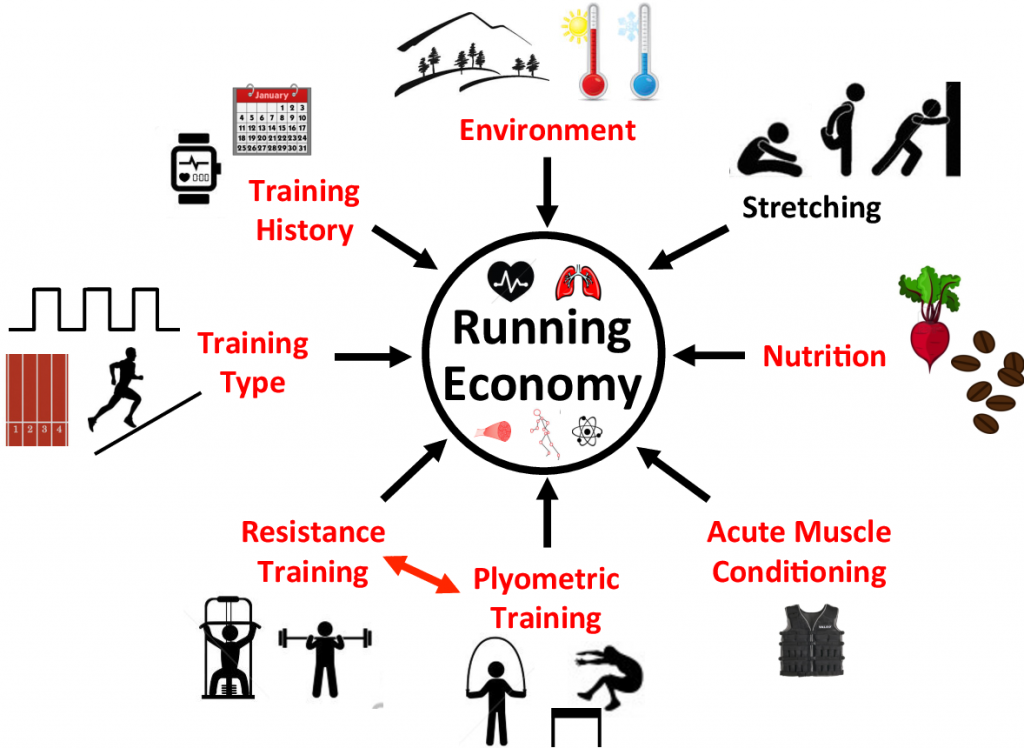Key Points
- Running economy is how efficiently your body uses oxygen while running at a steady pace.
- It’s a big deal for distance runners—sometimes even more important than how much oxygen you can take in at your max.
- Things like your running style, strength, and training can make you more efficient.
- You can improve it with practice, strength exercises, and tweaking your form.
- Fun fact: Marathon runners are better at saving energy at slower speeds (6-12 mph) than sprinters, even though sprinters are kings of short bursts.
What’s Running Economy All About?
Think of running economy like your car’s gas mileage—it’s how much oxygen you need to keep running at a certain speed. The less oxygen you use, the better your “mileage,” or running economy. Scientists measure this by checking how much oxygen you breathe in (called VO2) while jogging at a steady pace, usually on a treadmill.

Why Should Runners Care?
If you’re into long-distance running—like marathons or half-marathons—running economy is your secret weapon. It means you can go farther and faster without burning out. Research even says it’s a better predictor of how well you’ll do in a race than your max oxygen capacity (VO2 max), especially for seasoned runners (Factors affecting running economy in trained distance runners).
How to Get Better at It
Want to run more efficiently? Here’s what you can do:
- Mix Up Your Training: Try short, fast intervals to boost your lung power, plus long, slow runs to build stamina.
- Hit the Gym: Strength exercises like squats or planks make your legs and core stronger, so each step takes less effort.
- Check Your Form: Record yourself running or ask a coach to spot wasted movements—like bouncing too much—and fix them.
Marathon Runners vs. Sprinters: A Cool Twist
Here’s something neat: marathon runners are champs at saving energy when running at slower speeds (6-12 mph or 10-19 km/h). Sprinters and middle-distance runners? Not so much—they tend to bounce more, which uses extra energy. That’s because marathoners train for hours of steady effort, while sprinters focus on explosive speed for short races.
Your Guide to Running Economy: Save Energy, Run Better
Hey runners! Ever wondered why some people can keep going forever while others tire out fast? It’s all about something called running economy. Let’s break it down in a way that’s easy to get—and how you can use it to crush your next run.
What’s Running Economy?
Picture this: you’re jogging along, and your body’s using oxygen to keep you moving. Running economy is how little oxygen you need to run at a set speed. Use less oxygen? You’ve got great running economy! It’s like getting more miles out of a tank of gas. Scientists test this by measuring your oxygen intake (VO2) while you’re on a treadmill.

Why It’s a Big Deal
For anyone who loves long runs—think 10Ks, half-marathons, or full marathons—running economy can make or break your race. The more efficient you are, the longer you can run without feeling wiped. Studies show it’s often more important than your max oxygen level (VO2 max) for predicting how you’ll do, especially if you’re already in decent shape.
What Affects How Efficient You Are?
Lots of stuff plays a role—here’s the rundown:
- How You Run: Bouncing too much or flailing your arms wastes energy. Smooth and steady is the way to go.
- Your Muscles: Stronger legs and a solid core mean less effort per step.
- Training: Long runs and speed work both help your body get better at using oxygen.
- Gear: Lightweight shoes and comfy clothes can make a difference.
- Weather: Heat or hills can make you work harder, so they matter too.
Tips to Run Smarter, Not Harder
Good news—you can totally improve your running economy! Try these:
- Switch Up Your Runs: Do some fast sprints one day, then a chill long run the next. It trains your body to handle anything.
- Build Strength: Add some lunges, squats, or planks to your routine. Strong muscles = easier running.
- Watch Yourself Run: Grab your phone, record a video, and see if you’re bouncing too much or swinging your arms wild. Small tweaks can save tons of energy.
- Stay Light: Dropping extra weight (if it’s safe) makes every step easier—just don’t lose muscle!
Marathoners Beat Sprinters at This Game
Here’s a fun twist: marathon runners are super efficient at speeds between 6 and 12 miles per hour (10-19 km/h). Sprinters and middle-distance runners? They use more energy at those paces because they’re built for speed, not stamina. Picture a marathoner gliding along while a sprinter’s hopping more—it’s all about what they train for.
Wrap-Up: Run Longer, Feel Stronger
Running economy is your ticket to better, easier runs. Whether you’re chasing a personal best or just want to enjoy your jogs more, being efficient is key. Train smart, tweak your form, and watch how far you can go without breaking a sweat (well, almost!). Got a race coming up? Start working on this now—you’ll thank yourself at the finish line.
